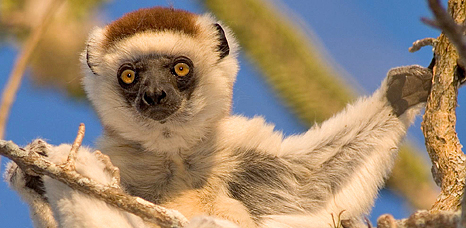John Plowman travelled on our 'Madagascar's Lemurs' holiday and submitted this entry to our writing competition.
Verreaux's Sifaka by Paul Stanbury
Madagascar. Once the land of the giant 10 foot Elephant Bird and of the legendary Dog-headed Man, an island separated from Africa millions of years ago with unique plants, birds and animals, notably lemurs, ecological niche fillers. A must see.
At Antananarivo, we watched Black Egrets fishing on Lake Anosy by ‘mantling’ - wings spreading elegantly over the water to shield it from the sun. A Madagascar Little Grebe sighting turned to disappointment as the scope targeted a bobbing bottle. A park for rescued lemurs enabled us to get up close and personal with many of the remarkable lemur species we were hoping to see later.
We headed south from the capital across hot red earth lumpy with termite mounds, villages of thatched huts interspersed with grey clay valleys intensively farmed for rice - splashes of bright green - low mud wall barriers providing a home for fish and frogs. Egrets and Purple Herons stalked.
Dawn at Ranomafana: leaving the misty Namorana river our expert guides, Paul and Rivo, led us through the dense montane rainforest of giant bamboo, guava bushes and ferns to our first tantalising glimpses of lemurs in the wild: dark patches among the light filtering through the branches high above. The chestnut-coloured Small Toothed Sportive Lemur and, later, the recently discovered Golden Bamboo Lemurs were chewing high in the canopy.
Down in the leaf litter reclusive birds like the Madagascar Wood Rail and Pitta-like Ground Roller scuttered past ... then an iridescent green flash of the Velvet Asity. Chameleons, a Madagascar Tree Boa, little orchids and brightly coloured butterflies in sunlit glades or by gin-clear streams appeared in this patch of Eden. At night, torch-lit mouse lemurs ate honeyed banana.
Westwards across dry savannah brought us at dusk to a moonscape of bare rock and the massive sandstone monoliths of the Isalo national park, and our stunning hotel: stone villas around a pool. We glimpsed Madagascar Bee-eaters and Forest Rock Thrush; Madagascar Kestrels perched menacingly on the rocks. A dusk walk added busy Madagascar Button-Quail and the handsome Crested Drongo.
Next day at Zombitse, we gasped at a family of Verreaux’s Sifakas in a distant tree: a blur of white and dark brown which, seconds later, leapt across branches to disappear into the dense forest. Vision or reality? We headed to the coast at Toliara then north beside the mangroves overlooking the Indian Ocean. That night the distant roar of breakers on the reef and the softer sound of small waves lapping on the shore beside our reed-thatched huts lulled us to sleep.
The Reniala spiny forest was what it said on the tin. The cactus-like octopus tree, succulents and baobabs in orange-red sand, looked unpromising, yet we saw three types of coua, sunbirds and the remarkable Sub-desert Mesite, which obliging settled above us. It was ‘three men in a boat’ that afternoon as a brightly painted pirogue took some of us to snorkel off the reef. Magic.
Later, one of our party called on a nearby village to present its leader with a football (plus nozzle for a pump). Anglo-Malagasy relations hit a new high.
Dusk gave us Madagascar Hoopoes, a Torotoroka Scops Owl and chameleons. The next day at the Aristokay Arboretum we saw at close quarters the fan shaped Bismark Palm, Vanilla Orchid, Napoleon’s Hat and numerous other plant species. The unassuming museum had a reminder of the age of the Dodo: a huge egg of the Elephant Bird.
The Andasibe-Périnet Reserve yielded a cornucopia of birds, Rufous and Blue Vangas, Fodies, Madagascar Paradise Flycatchers and Madagascar Nightjars. At night, we saw the beady eyes of Eastern Woolly and Goodman’s Mouse Lemurs and heard for the first time the eerie cry of the Indri.
To Mantadia to see the Eastern Grey Bamboo and Black-and-White Ruffed Lemurs, asities and a tantalising glimpse of the Madagascar Flufftail. At a nearby lake a whinnying trill led us to a pair of - yes - Madagascar Little Grebes. Hardly had the excitement died down than a tenrec appeared, hedgehog-like and dashing about in all directions, its hibernation accidentally but delightfully interrupted.
We had good views of the Indri high up in the canopy. With a small stretch of the imagination early travellers could have turned the white and black coated woolly 2-legged mammal into the Dog-headed Man. Add to that the extraordinary roar they emit at dusk and dawn, carrying for up to two miles, and they could have become the stuff of legend.
It was a privilege to have seen briefly a wealth of remarkable plants, trees, birds (nearly 100 different types,), reptiles and above all lemurs (some 18 species in all) in pockets of this fragile but stunningly beautiful Lost World. Let’s hope they cling on.
Read more about our 'Madagascar's Lemurs' holiday.



 Loading search...
Loading search...
